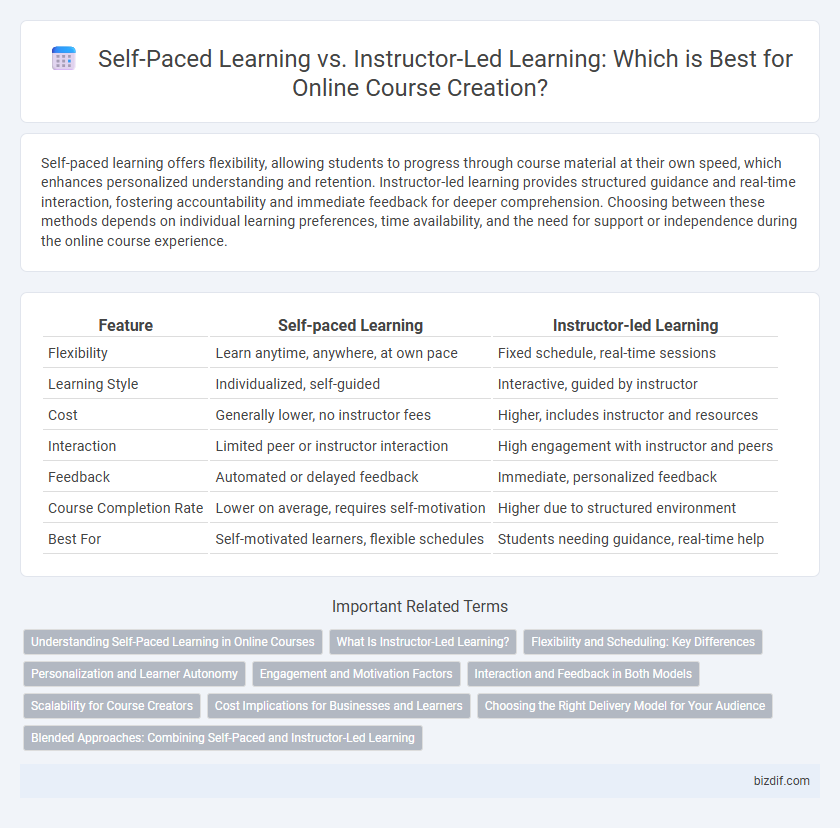Self-paced learning offers flexibility, allowing students to progress through course material at their own speed, which enhances personalized understanding and retention. Instructor-led learning provides structured guidance and real-time interaction, fostering accountability and immediate feedback for deeper comprehension. Choosing between these methods depends on individual learning preferences, time availability, and the need for support or independence during the online course experience.
Table of Comparison
| Feature | Self-paced Learning | Instructor-led Learning |
|---|---|---|
| Flexibility | Learn anytime, anywhere, at own pace | Fixed schedule, real-time sessions |
| Learning Style | Individualized, self-guided | Interactive, guided by instructor |
| Cost | Generally lower, no instructor fees | Higher, includes instructor and resources |
| Interaction | Limited peer or instructor interaction | High engagement with instructor and peers |
| Feedback | Automated or delayed feedback | Immediate, personalized feedback |
| Course Completion Rate | Lower on average, requires self-motivation | Higher due to structured environment |
| Best For | Self-motivated learners, flexible schedules | Students needing guidance, real-time help |
Understanding Self-Paced Learning in Online Courses
Self-paced learning in online courses allows students to access materials anytime, accommodating diverse schedules and learning speeds. This format promotes autonomy by enabling learners to control the pace and sequence of content consumption, enhancing knowledge retention and engagement. Flexibility and personalized progression make self-paced courses ideal for individuals balancing education with work or personal commitments.
What Is Instructor-Led Learning?
Instructor-led learning (ILL) is a structured form of online course delivery where a qualified instructor guides students through the material using live or scheduled sessions. This method ensures real-time interaction, immediate feedback, and personalized support, enhancing student engagement and accountability. ILL is ideal for complex subjects requiring direct clarification and collaborative learning environments.
Flexibility and Scheduling: Key Differences
Self-paced learning offers unmatched flexibility, allowing learners to access course materials anytime and progress at their own speed, ideal for busy schedules and diverse time zones. Instructor-led learning follows a fixed schedule with live sessions that promote real-time interaction but require participants to be available at specific times. Choosing between these formats depends on individual preferences for control over study time versus structured guidance and immediate feedback.
Personalization and Learner Autonomy
Self-paced learning offers high personalization, allowing learners to control their study pace and customize content based on individual needs, which enhances autonomy and motivation. Instructor-led learning provides structured guidance and immediate support but limits personalization due to fixed schedules and standardized content delivery. Emphasizing learner autonomy, self-paced courses empower users to adapt resources and timelines, fostering deeper engagement and self-regulated learning skills.
Engagement and Motivation Factors
Self-paced learning offers flexibility, allowing learners to progress at their own speed, which boosts motivation through personalized control over their study schedule. Instructor-led learning enhances engagement by providing real-time interaction, immediate feedback, and social accountability that drive active participation and motivation. Research on online course creation highlights that combining self-paced elements with instructor-led sessions maximizes learner engagement and sustained motivation.
Interaction and Feedback in Both Models
Self-paced learning offers flexible interaction through asynchronous tools like discussion forums and quizzes, enabling learners to engage at their own pace but often limiting immediate feedback. Instructor-led learning provides real-time interaction via live sessions and direct communication, facilitating instant feedback and personalized guidance. Effective online course creation balances these models by integrating interactive elements and timely feedback mechanisms to enhance learner engagement and comprehension.
Scalability for Course Creators
Self-paced learning offers unparalleled scalability for course creators by allowing content to be accessed anytime, accommodating a limitless number of students without additional instructor effort. Instructor-led learning requires synchronized sessions and personalized interaction, which can limit enrollment capacity and increase resource demands. Automating assessments and leveraging video modules further enhance scalability in self-paced courses, making them ideal for reaching a broad audience efficiently.
Cost Implications for Businesses and Learners
Self-paced learning significantly reduces costs for businesses by minimizing the need for live instructors and physical infrastructure, allowing learners to access materials anytime without additional fees. Instructor-led learning incurs higher expenses due to salaries, scheduling complexities, and potential travel or accommodation costs for in-person sessions. Businesses and learners must weigh these financial factors against the value of personalized interaction and real-time feedback inherent in instructor-led courses.
Choosing the Right Delivery Model for Your Audience
Selecting the right delivery model for your online course depends heavily on audience preferences, learning objectives, and flexibility needs. Self-paced learning offers autonomy and convenience, ideal for learners seeking flexible schedules and personalized pacing, while instructor-led learning provides structured guidance, real-time interaction, and immediate feedback, enhancing engagement and accountability. Analyzing learner demographics and goals enables course creators to optimize engagement and knowledge retention by aligning the delivery method with user expectations.
Blended Approaches: Combining Self-Paced and Instructor-Led Learning
Blended learning approaches integrate self-paced modules with instructor-led sessions to enhance flexibility and engagement in online course creation. This combination leverages asynchronous content for personalized pacing while providing real-time interaction and immediate feedback through live instruction. Research indicates that blended learning improves knowledge retention and learner satisfaction by accommodating diverse learning preferences and fostering collaborative skills.
Self-paced Learning vs Instructor-led Learning Infographic

 bizdif.com
bizdif.com